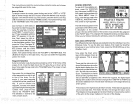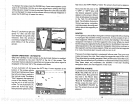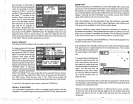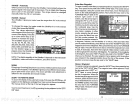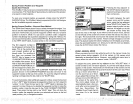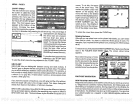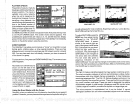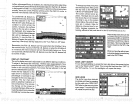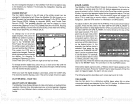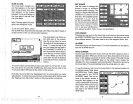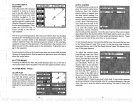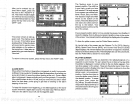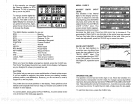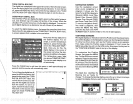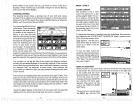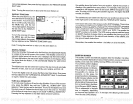
All of the
navigation displays
on the UltraNav II will show
navigation
data
to the location
you
marked. This includes the
navigation,
steering,
and
plotter displays.
CHANGE DISPLAY
The four
digital
displays
on the left side of the
plotter
screen can
be
changed
or customized at will. When the UltraNav II is first turned
on,
or
after it's
preset,
the four
digital displays
are Distance To Go
(DTG), Speed
Over Ground
(SOG), Bearing
to
waypoint (BRG),
and
Course Over
Ground
(COG).
The available
displays
that can be
placed
in
these
windows are: Distance To Go
(DTG), Speed
Over Ground
(SOG),
Bearing
to
waypoint (BRG),
Course Over Ground
(COG),
Cross track error
(XTE),
Water
depth (DEPTH),
and
Altitude
(ALT).
To
change any
or all of the
digital displays,
first
press
the
MENU
key
while the
plotter
is
showing.
Now
press
the
key
next to the "CHANGE DIS-
PLAY" label. The unit returnsto
the
plotter
screen with a black
box
surrounding
the DTG box.
This means the DTG box is
readyto
be
changed.
Pressthe
left or
right
arrow
keyto change
the
display.
For
example,
to
change
the Distance To Go to
N 36°09,fl21' bi 95°SU.54O'
rk
N
700
L1'I
22.0
lii
34°
.
2111
Cross Track Error
(XTE), press
the
right
arrow
key
four times.
To
change
another
digital box, press
the
up
or down arrow
key
until the
flashing
box is on the desired
display.
Now
press
the
right
or left arrow
key
until the desired
display appears.
When
you
have the
digital displays customized, press
the CLEAR
key.
This locks the screen
displays,
even if the unit is turned off and on
again.
PLOTTER MENU
-
PAGE TWO
SELECT UNITS OF MEASURE
The UltraNav II can
display
distance in
miles, kilometers,
or nautical
miles,
velocity
in miles
perhour,
kilometers
per
hour,
or
knots,
bearing
in
degrees
magnetic
or
true,
Altitude in feet or
meters,
and time in 12 hour or 24 hour
format.
SONAR
ALARMS
The UltraNav
II has three different
types
of
sonar alarms. The first is
the
Fish Alarm. It sounds
when
the
Fish
l.D. feature determines an echo or
group
of echoes is a fish. Another alarm is the Zone Alarm which
consists
of a bar.
Any
echo that
appears
inside this bar
triggers
the alarm. The
last
alarm is
called
the
Depth
Alarm.
Only
the bottom
signal
will
trigger
this
alarm.
This is useful as an anchor
watch,
a
shallow water
alert,
or for
navigation.
See the GPS section for information on
GPS alarms.
To
adjust
an
alarm,
first
press
the
ALARM
key.
The screen shown
below
appears.
Press the
key
next to the "SET
DEPTH OR GPS ALARMS" to
adjust
the shallow
or
deep digital
alarms. When
you press
the
key
next to
the "SET DEPTH OR GPS
ALARMS",
the menu shown at the
top
of the
next
page appears.
The zone
alarm has its own menu which
is shown and described in the
LET
DEPTH OR GPS
i'ILARMS
zone alarm section. Once
yOu
see this
screen, press
the down
arrow
key
until the black box is
on the
desired alarm. In this
example,
the shallow
alarm is
selected,
Now
press
the
key
next to the 'CHANGE VALUE"
label. Use the numbered
keys
to set thealarm. For
example,
to setthe shallow alarm's value
to 10
feet, press
the 1
key,
then
I_____ TURh FISH ALM ON
E<IT TURN ZuNE
4LM ON
press
the 0
key.
When the desired value has been
entered,
press
the
key
next to the "ENTER" label. The unit returns
to the ALARMS screen.
When either
depth
alarm
sounds,
a "Silence
Alarm" label
appears
at the
bottom of the screen. Press the "CLEAR"
keyto
mutethe alarm. When the
alarm is
triggered again,
the alarm
will also sound.
The
following
section
describes each
sonar alarm and its limits.
FISH ALARM
Use the fish alarm for a distinctive audible alarm when fish or other
suspended objects
are detected
by
the Fish l.D. feature. A
different tone
sounds for each fish
symbol
size shown on the
display.
58 19
PDF compression, OCR, web-optimization with CVISION's PdfCompressor



